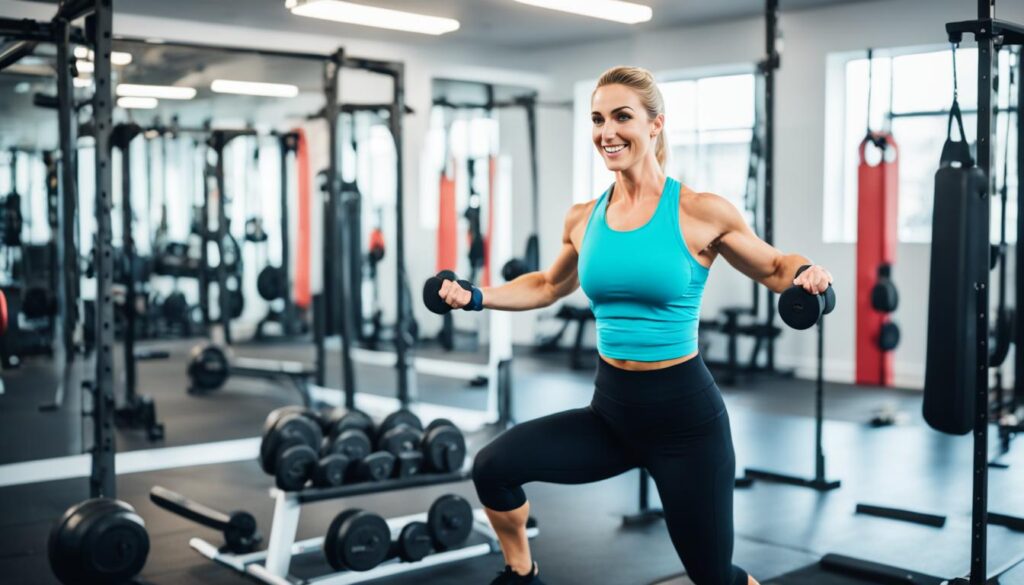Are you new to the world of fitness and feeling overwhelmed by the plethora of workout options out there? Fear not! Crafting the best beginner workout routines can be a game-changer in your fitness journey1. These routines are designed to help you build strength, endurance, and confidence gradually, paving the way for long-term success.
Embarking on a new fitness regime can be daunting, but with the right approach, you can transform your body and mind. From full-body workouts to targeted strength training and cardio-focused plans, this article will guide you through the best beginner workout routines to help you achieve your goals1. Get ready to unlock your true potential and discover the joy of fitness, one step at a time.
Key Takeaways
- Beginner workouts should start with 3-4 days per week to avoid overtraining and allow for proper recovery1.
- Effective full-body routines for beginners should last 30-45 minutes and combine strength, cardio, and mobility exercises1.
- Proper warm-up and cool-down can help prevent muscle soreness and reduce the risk of injury1.
- Beginner workout plans provide structure, boost confidence, and help avoid making exercises up on the spot1.
- Tracking progress is crucial for monitoring improvements and adjusting workouts accordingly1.
Setting Realistic Goals for Your Workout Journey
Embarking on a fitness journey is an exciting and rewarding experience, but it’s essential to set realistic goals to ensure long-term success2. Creating a long-term exercise routine is all about forming positive habits, which means giving your mind and body the time to adjust to doing something new2.
When setting fitness goals, it’s important to consider both short-term and long-term objectives. Start by setting a goal to continue with the workout program for three months2. This timeframe allows you to establish a consistent routine and see tangible progress, which can provide the motivation to keep going2.
As you progress, you can set more ambitious goals, such as improving specific fitness markers2. For example, you can aim to increase your resting heart rate, plank hold duration, or the number of bodyweight squats you can perform in a minute2. These measurable goals will help you track your progress and stay motivated.
Remember to maintain a balanced approach to your workout routine2. Incorporating a mix of cardio and strength training, along with flexibility exercises, will help you achieve comprehensive fitness development2. Aim for a schedule that includes three cardio sessions and two strength-training sessions per week, with time allotted for stretching or yoga twice a week2.
Setting long-term goals, such as working up to a 5K run over three months, can also be a great way to challenge yourself and improve your endurance2. However, it’s essential to listen to your body and adjust your goals and workout plans accordingly to prevent burnout and injury2.
Remember, the key to a successful fitness journey is to set realistic, measurable, and sustainable goals that align with your aspirations and current capabilities2. By doing so, you’ll be well on your way to forming positive habits and achieving your desired fitness outcomes2.
“Consistency is key for building exercise habits and seeing results. Start with a manageable goal of three workouts a week.”3 – Mike Donavanik
| Fitness Goal | Recommended Approach |
|---|---|
| Walking 10,000 steps per day | Focus on an average for the month to ease pressure3. |
| Push-ups | Start with beginner variations like incline, knee, or combo push-ups before progressing3. |
| Recovery and Flexibility | Rest for at least two days a week and incorporate light movement like walking or gentle yoga3. Stretch specific muscles post-workout for 15 to 45 seconds3. |
| Hydration | Drink plenty of water throughout the day, considering factors like activity level, diet, body weight, and climate3. |
| Running a 5K | Plan at least 12 weeks ahead, aiming to run three times a week3. |
In addition to setting specific fitness goals, it’s important to consider the overall principles of a well-rounded workout plan4. Aim for at least 150 minutes of moderate-intensity or 75 minutes of high-intensity cardio per week to support cardiovascular health4. Incorporate strength training exercises 2-3 times per week to improve muscular strength, endurance, and metabolic rate4.
Proper nutrition also plays a crucial role in your fitness journey4. Consuming a post-workout meal within 30 minutes of completing a workout can prevent muscle breakdown, and a Recovery Shake with a 3:1 ratio of carbs to protein is recommended4. Additionally, aim to consume ½ – ¾ of a gram of carbs per pound of body weight immediately following a workout4.
Incorporating a Performance Food Centers smoothie bar in your gym can provide a convenient and nutritious solution for your post-workout recovery needs4. These turnkey solutions include equipment, products, training, and ongoing support to help gym owners offer their members clean energy from all-natural ingredients, improving workout performance and faster recovery times4.
By setting realistic, measurable, and sustainable fitness goals, and following a balanced approach to your workout routine and nutrition, you’ll be well on your way to a successful and rewarding fitness journey2. Remember to listen to your body, adjust your goals as needed, and embrace the process – the rewards will be well worth the effort2.
Understanding Workout Basics
Establishing a consistent workout routine is crucial for achieving your fitness goals5. Regular exercise can improve your health significantly, helping to reduce the risk of chronic diseases and manage your weight5. The primary benefits of exercise include maintaining a healthy body weight, building muscle mass, boosting mental health, improving sleep quality, and increasing energy levels5.
When it comes to the basics of a workout routine, there are a few key elements to consider6. The minimum recommendation for exercise is at least 150 minutes per week, and a Monday-Wednesday-Friday routine works well for most people6. You should always leave 48 hours between workouts to allow your muscles to rest and recover properly6.
Reps, Sets, and Weight Selection
Reps (repetitions), sets, and weight selection are crucial for achieving your fitness goals7. The suggested beginner workout routines include doing cardio three times a week and strength training three times a week, with the intensity starting at a moderate level and gradually increasing7. When it comes to weight selection, it’s best to start at the lower end of the spectrum and work your way up until you reach about 60 to 70% of your maximum limit5.
It’s important to listen to your body and not push through pain during your workouts5. Warm-up exercises can help prevent injuries and improve athletic performance, while cooling down after your workout can help your body return to a normal state and reduce muscle soreness5.
Staying hydrated and consuming a balanced diet with all food groups can also support your fitness program5. Mixing up your activities, tracking your progress, joining a gym, or working out with a friend can help you maintain motivation for exercise5.
“The key to a successful workout routine is consistency and gradually increasing the intensity and duration of your exercises. Remember to listen to your body and allow for proper rest and recovery.”
By understanding the basics of workout routines, you’ll be well on your way to achieving your fitness goals and improving your overall health and well-being576.
Beginner Gym Workout for Females
Designing a beginner gym workout routine for women is all about finding the right balance between strength training, cardio, and recovery. This workout plan is crafted to tone the entire body, with a slight emphasis on the legs and glutes8. It includes a variety of exercises that target multiple muscle groups, helping women build a strong, lean foundation9.
Strength Training Exercises
- Seated Leg Press: 4 sets of 10 reps8
- Seated Shoulder Press: 4 sets of 10 reps8
- Close Grip Lat Pulldown: 4 sets of 10 reps8
- Bodyweight Lunges: 4 sets of 10 reps per leg8
- Full/Kneeling Push-Ups: 4 sets of 10 reps8
To ensure proper form and progression, it’s recommended to start at the lower end of the weight spectrum and gradually increase the resistance as you become more comfortable with the exercises10.
Core and Stability Exercises
These core and stability exercises help to strengthen the abdominal muscles, improve posture, and provide a solid foundation for the other exercises in the workout9.
“This workout plan is designed to help women build a strong, toned, and functional body, while also improving their overall fitness and well-being.” – Kristen McParland, CPT, NASM-certified personal trainer and certified nutrition coach9
Remember, consistency is key when it comes to any beginner workout routine. Start by focusing on proper form and gradually increase the intensity and weight as you become more comfortable with the exercises10. By sticking to this beginner gym workout for females, you’ll be well on your way to achieving your fitness goals and building a strong, healthy body.
Beginner Gym Workout for Males
As a beginner in the world of fitness, crafting an effective workout routine is crucial for building strength and lean muscle mass. This beginner gym workout for men is designed to help you achieve your goals and set the foundation for a successful fitness journey11.
The key focus of this workout is to target the arms and core, while also providing a comprehensive full-body training session. It includes exercises like seated chest press, seated rows, wide grip lat pulldown, seated leg press, dumbbell seated shoulder press, dumbbell bicep curls, close grip tricep press ups, cable rotations/twists, and reverse crunches11.
To ensure a balanced approach, the workout plan follows a three-day-per-week schedule, allowing for adequate rest and recovery between sessions11. The suggested rest intervals range from 60 to 90 seconds, which helps optimize performance and muscle growth11.
As a beginner, it’s essential to focus on proper form and technique to prevent injuries and maximize the effectiveness of your workouts11. Start with lighter weights and gradually increase the intensity as your strength and endurance improve11.
Remember, consistency is key. Stick to this beginner gym workout for men, and you’ll be well on your way to building a strong foundation for your fitness goals11. Whether your aim is to gain strength, build lean muscle, or simply improve your overall fitness, this program is a great starting point12.

“The beginner’s workout routine includes exercises like dumbbell squats, pushups, and seated calf raises. The article advises beginner gym-goers to focus on proper form, recover adequately, and avoid overexertion to prevent injuries.”11
As you progress through the workout plan, you can gradually increase the intensity and challenge yourself further13. The program is designed to help you build a strong foundation and prepare you for more advanced training in the future12.
Remember, the journey to fitness is a marathon, not a sprint. Stay dedicated, listen to your body, and enjoy the process. With this beginner gym workout for men, you’re well on your way to becoming the best version of yourself11.
Beginner Gym Workout for Strength
For beginner strength training, the focus should be on exerting more energy for fewer repetitions, which typically means lifting heavier weights14. The rep range for strength training is 4–6 reps, and this plan is designed to help you build significant muscle mass and power14. This beginner gym workout for strength includes exercises like barbell push press, goblet squat, dumbbell single arm row, shoulder lateral raise, bench press, pull-ups/assisted pull-ups, barbell bicep curls, cable overhead tricep extensions, and rotating plank.
Strength training is crucial for beginners to improve overall body composition, increase bone density, and enhance functional movement15. According to research, strength training just twice per week can significantly increase muscle mass15. The key to an effective and enjoyable strength training routine is to start with a foundation of exercises that work each part of the body, focusing on multi-joint, compound movements that engage the most muscle fibers15.
- Barbell Push Press: 4-6 reps, 3 sets
- Goblet Squat: 4-6 reps, 3 sets
- Dumbbell Single Arm Row: 4-6 reps, 3 sets per arm
- Shoulder Lateral Raise: 4-6 reps, 3 sets
- Bench Press: 4-6 reps, 3 sets
- Pull-ups/Assisted Pull-ups: 4-6 reps, 3 sets
- Barbell Bicep Curls: 4-6 reps, 3 sets
- Cable Overhead Tricep Extensions: 4-6 reps, 3 sets
- Rotating Plank: 30 seconds, 3 sets
Remember to start with a weight that allows you to complete a full set of 12 to 15 repetitions and gradually increase the load as you become stronger16. Warm-up exercises before your workout and cool down afterward are also essential for reducing muscle soreness and injury risk16.
“Strength training is a crucial component of a well-rounded fitness routine, especially for beginners. It not only builds muscle but also improves balance, bone density, and overall functional movement.”
By incorporating this beginner gym workout for strength into your fitness plan, you’ll be well on your way to building a solid foundation of muscle and power14. Remember to be patient, listen to your body, and progressively increase the challenge as you become stronger151416.
Beginner Gym Workout for Fat Loss
When it comes to weight loss, a balanced approach that combines cardio, strength training, and proper nutrition is key. For beginner fitness enthusiasts, a carefully structured workout routine can be highly effective in shedding excess pounds and improving overall health17.
The recommended beginner workout for fat loss includes a combination of brisk walking, strength training with dumbbells or weights, and circuit training. Participants are advised to walk six days in a row and take one day off, with strength training exercises incorporated into the routine17. The strength training routine consists of eight dumbbell exercises, with three sets of 12 repetitions for each exercise17. Additionally, the workout program includes one weekly circuit training session that combines weights and cardio17.
To maximize weight loss, the workout emphasizes at least 40 minutes of brisk walking six days a week, with the option to add slow jogs to the walks17. Integrating non-exercise activities throughout the day, such as parking farther from work entrances or taking the stairs instead of the elevator, can further enhance the overall exercise regimen17.
Alongside the exercise plan, a high-fiber diet rich in healthy fats, whole grains, fruits, vegetables, lean proteins, and low-fat dairy or plant-based alternatives is crucial for weight loss success17. Before starting any exercise program, it is recommended to consult with healthcare providers to customize weight-loss goals, exercise intensity, frequency, and nutrition plans based on individual health conditions and requirements17.
Research suggests a correlation between rising rates of obesity and increased rates of metabolic and cardiovascular diseases, leading to major health problems18. Effective exercise programs can accelerate weight loss, but long-term weight management necessitates sustained healthy habits over time18.
The 4-week workout program for weight loss combines cardio and strength training to boost metabolic rate and initiate weight loss18. Strength training helps build muscle, increase metabolism, and burn more calories even at rest, while interval training provides a post-workout metabolic boost, enhancing aerobic benefits and maintaining high intensity for improved metabolic activity18. Low-intensity cardio contributes to daily calorie burn and allows for recovery after intense workouts18.
Each workout in the 4-week program lasts approximately 20-22 minutes, designed for busy schedules and effective weight loss18. The program structure includes upper and lower body strength training, interval training/conditioning, and low-intensity cardio sessions to target weight loss comprehensively18. Week-to-week progression involves enhancements in weight lifting, cardio intensity, and the number of rounds in conditioning workouts for gradual improvement and results in weight loss18.
The suggested 8-week beginner program for weight loss combines four cardio sessions per week, each lasting 20-30 minutes at a 70% Zone 2 heart rate intensity, along with a four-day weight training program19. The weight training sessions are approximately 45-75 minutes long, focusing on compound exercises and training all major muscle groups effectively19. Each weight training session involves sets with a moderate weight, a heavier challenging weight, and a heaviest weight reaching failure, plus bodyweight-only ab exercises, with 90-second rest periods between sets and exercises19.
The 8-week routine emphasizes simplicity, progressive overload, and consistency in training, along with the importance of a healthy diet and basic supplements like multivitamins and protein powders19.

What are the best beginner workout routines?
Beginner gym workouts for flexibility are essential for relieving tight areas and improving overall mobility20. Adults should aim for at least 150 minutes of moderate-intensity aerobic activity or 75 minutes of vigorous-intensity aerobic activity weekly as per the U.S. Department of Health and Human Services guidelines21. The recommended workout routine is based on a 3-day full-body split with an alternating “ABA BAB” format, consisting of 2 actual workouts repeated in an alternating manner over the course of two weeks. Each workout focuses on compound exercises with 3 sets of 8-10 reps for each exercise, with rest periods between sets set at 2 minutes.
21 The workout emphasizes proper form and consistent progression with a focus on using the same weight for all sets and gradually increasing the weight. Beginners are advised to start with lighter weights to focus on perfecting form before increasing the load. This routine is designed to take advantage of beginners’ ability to progress quickly and efficiently in weight training, with a structure for higher frequency, lower volume, and basic exercise selection to optimize results for fitness newbies.
22 Weight lifting sessions should be kept to 45–90 minutes for effectiveness, with warm-up sets required before weight lifting sets, and only one warm-up set per muscle group. Weight lifting is recommended to be done 3–5 times per week, with 1–2 rest days per week from weight training being necessary. The push-pull-legs program is suggested for structuring weight training, with each muscle group given 24–48 hours rest and rest between sets of 2–3 minutes.
22 Compound exercises must be the focus of a beginner workout routine for muscle and strength building, with the best chest exercises including Barbell Bench Press and Dumbbell Bench Press, top back exercises including Barbell Deadlifting, Pull-ups, and Barbell Row, and recommended leg exercises consisting of Barbell Back Squat, Leg Press, and Lunges. Essential bicep exercises include Dumbbell Curl, Barbell Curls, and Hammer Curls, while tricep exercises should include Tricep Push-down, Standing Overhead Dumbbell Tricep Extension, and Dips.
This beginner flexibility workout requires a mat and open space, and it includes exercises like child’s pose into upward dog, hip openers, kneeling shoulder stretches, thoracic rotation raises, frog pose, hip flexor stretches, lateral lunges, and scorpion twists21.
Beginner Video Session
When it comes to starting a fitness journey, having access to expert-led workout videos can be incredibly valuable for beginner fitness enthusiasts23. Over 50 fitness apps were tested to determine the best workout apps for beginners23, and several standout video-based options emerged as top choices.
Caliber was rated as the Best Workout App for Beginners overall23, offering a variety of beginner-friendly exercise routines led by certified trainers. Aaptiv was recognized as the Best Beginner Workout App for Variety23, providing users with a wide range of audio-guided workouts, including strength training, cardio, and yoga. For those seeking a more personalized experience, Future was highlighted as the Best Personal Training Workout App for Beginners23, connecting users with dedicated coaches to create customized workout plans.
In addition to fitness apps24, 9 best workout videos for beginners were reviewed in the article. The RIPT90 program boasts of showing results in a leaner and stronger physique after just 90 days24, while the ‘Beach Babe’ workout series by Katrina Scott and Karena Dawn includes two discs and seven workouts focusing on HIIT, yoga routines, and core exercises24. For those interested in introducing Pilates into their routine, New Body Pilates by Jennifer Kries is a recommended option24.
- Cathe Friedrich XTrain Series Hard Strikes provides a mix of kickboxing and cardio workouts24.
- Simple Seated Chair Exercises for Seniors is recommended for individuals over 50 and beginners of any age to improve range of motion and prevent joint issues24.
- Suzanne Bowen: BarreAmped Boot Camp is ideal for those interested in barre workouts with a boot-camp style24.
When selecting workout videos for beginners, it’s essential to look for exercises that are beginner-friendly, offer a variety of workout styles, and provide opportunities for progress24.

Alongside workout videos25, experts recommend that beginners start with lighter weights and gradually increase intensity each week25. For women, starting with 5-pound and 10-pound dumbbells is suggested, while men may begin with 10-pound, 15-pound, 20-pound, 25-pound, 30-pound, 35-pound, and 40-pound dumbbells25. To avoid injuries and steadily improve strength, it’s advised to increase the weight by 5 to 10 percent every four to six weeks25. Beginners should aim for 2 to 3 sets of each exercise, with 1 to 3 minutes of rest in between sets25.
Some of the specific beginner exercises recommended include squats, glute bridges, push-ups, deadlifts, dumbbell rows, and farmer’s carry25. These exercises target different muscle groups and movement patterns essential for novice fitness enthusiasts, helping to strengthen muscles used in daily activities25.
“Variety in exercises helps in strengthening muscles used in daily activities such as picking up items off the floor or carrying heavy objects.”
By incorporating a mix of beginner-friendly workout videos, progressive weight training, and a diverse range of exercises, fitness newbies can establish a solid foundation for their workout journey and set themselves up for long-term success232425.
Beginner Gym Workout for Cardio Equipment
For fitness newbies, incorporating cardio workouts into your routine is crucial for improving cardiovascular health, endurance, and weight management26. Beginner gym cardio routines can be especially beneficial for individuals who have never exercised, are ready to get back on track, have been on a break due to illness or injury, or define their lifestyle as sedentary26.
To ensure maximum effectiveness, it’s recommended that beginners aim for a minimum of three cardio workouts per week26. These sessions can include a mix of steady-state and interval-based exercises, which can help elevate your heart rate and challenge your cardiovascular system in different ways27.
One beginner-friendly cardio workout on the treadmill might involve a 13-minute walking session26, while a stationary bike workout could last for 10 minutes26. As you progress, you can gradually increase the duration of these workouts by adding two or more minutes each week until you’re able to exercise continuously for 30 minutes26.
For a more challenging cardio routine, consider a 35-minute endurance workout that incorporates a combination of RPE (rate of perceived exertion) levels for specific intervals26. This workout can be extended to 60 minutes for weight loss by gradually adding intervals of increased intensity26. The goal is to meet the daily recommendations for moderate-intensity physical activity, which can significantly improve your overall fitness and cardiovascular health26.
If you’re new to the gym, don’t be intimidated by the cardio equipment. Start with simple activities like walking on the treadmill or using the elliptical machine for a full-body, low-impact workout27. You can also incorporate bodyweight exercises like jumping jacks, squats, and push-ups into your routine for an effective, equipment-free cardio session27.
Remember, the key to successful beginner cardio workouts is to start at a level that feels comfortable and gradually increase the intensity and duration over time27. By combining cardio with strength training, you’ll be well on your way to achieving your fitness goals and improving your overall health27.
“Walking is one of the most effective cardio activities, and research confirms its advantages for reducing the risk of cardiovascular disease.”28
The U.S. Department of Health and Human Services recommends that adults should engage in at least 150 minutes of moderate-intensity aerobic activity or 75 minutes of vigorous-intensity aerobic activity per week, spread over different days, to attain substantial health benefits from cardio workouts28. Additionally, incorporating a variety of cardio exercises, such as cycling, rowing, or HIIT workouts, can help prevent overuse injuries and keep your workouts engaging28.
By incorporating beginner-friendly cardio equipment and bodyweight exercises into your routine, you can effectively improve your cardiovascular fitness, strengthen your muscles, and work towards your fitness goals in a safe and sustainable way28.
Beginner Gym Circuit Program
Circuit training is a great way to expend more calories and target multiple areas at once, especially for those with a time limit on their sessions29. This type of workout incorporates weights, high cardiovascular fitness, muscular strength, muscular endurance, faster recovery, and helps beat boredom29.
A typical beginner circuit training program comprises 5-10 exercises performed back to back, with workouts usually ranging from 20 to 60 minutes29. High-Intensity Interval Training (HIIT) is often incorporated, involving exercises performed at maximal effort according to the Rate of Perceived Exertion Scale (RPE 8-10)29. HIIT utilizes smaller work-to-rest ratios, such as the Tabata style with 20 seconds of work followed by 10 seconds of rest for eight rounds29.
Beginner circuit programs may start with 1-2 sets of 10-15 repetitions or 30 seconds of work with 20 seconds of rest29. Intermediate circuit programs may entail 2-3 sets of 10-12 repetitions or 45 seconds of work with 10-20 seconds of rest29. Advanced circuit programs may involve 3-5 sets of 8-12 repetitions or 60 seconds of work with 10-30 seconds of rest29. Resting for one minute after completing one round of exercises is recommended29.
Professionals suggest progressing circuit training workouts gradually to build strength, flexibility, mobility, and endurance29. Modifications, like slowing down exercises or using elevation for assistance, are options to make circuit training easier for beginners29. For experienced individuals, incorporating more advanced techniques like isometric holds and time under tension can enhance workouts29.
Circuit training typically involves doing a series of 8 to 10 exercises with minimal rest in between, followed by a 30 to 60 seconds rest period and repeated two to three more times30. The average duration of a circuit training session ranges from 20 to 45 minutes, making it a time-efficient workout option30.
A 2021 systematic review and meta-analysis indicates that resistance-based circuit training programs performed two to three days a week lead to a decrease in fat mass and an increase in muscle mass30. Beginners are recommended to aim for two to three circuit training sessions per week, each lasting about 15 to 30 minutes30.
Circuit training allows for customization with various types available, such as timed circuits, competition circuits, and repetition circuits, offering flexibility in structuring workouts30. The workout goals primarily involve targeting multiple muscle groups in one session, improving heart health, positively impacting body composition, and preventing workout boredom30.
Circuit training allows individuals to perform exercises at home, the gym, or outdoors, providing flexibility in choosing a workout environment30. The benefits of circuit training include convenience, customization, time efficiency, enhanced heart health, and the ability to work multiple muscle groups simultaneously30.
Beginner gym machines are safer for newcomers as they follow a fixed pattern of movement and reduce the likelihood of injury compared to free weights exercises31. Full body workouts can lead to significant strength gains for beginners when training 2-3 times a week31. Including compound movements in a workout routine can efficiently work multiple muscle groups at once, saving time for beginners31.
A good workout routine should consist of 5-6 exercises, with 3-4 being compound exercises and the rest isolation exercises31. Recommended training sets for beginners range from 2-3 sets per exercise with 12-15 reps per set31. Following a workout plan with expert guidance can help beginners achieve muscle and strength building goals efficiently31.
Specific machines like leg press, chest press, lat pull down, bicep curl, hamstring curl, etc., are recommended for beginners to target various muscle groups effectively31. The workout designed for beginners suggests alternating between two full body workout plans for 2-3 times a week to ensure all muscle groups are adequately trained31. As beginners progress, a transition to free weights exercises is recommended to further challenge the muscles and enhance overall growth and strength31.
Exercise Principles to Help Reach Your Goals
Achieving your fitness goals is not just about the exercises you choose, but also the principles you apply to your workout routine. Whether you’re a beginner looking to start an exercise program or an experienced fitness enthusiast, understanding these key exercise principles can help you make the most of your workouts and reach your goals faster32.
One of the most important principles is consistency. Adults are recommended to incorporate 150 minutes of moderate aerobic exercise per, or 75 minutes of vigorous aerobic activity per as an equivalent32. Consistency is key, so try to establish a regular routine and stick to it, even on the days when you don’t feel like working out.
Another important principle is progressive overload. This means gradually increasing the intensity, duration, or difficulty of your workouts over time. A minimum of two strength training sessions per week is advised for, with at least 48 hours of rest between strength training sessions for muscle recovery32. As you become stronger, challenge yourself by adding more weight, reps, or sets to your strength training exercises.
Flexibility and balance are also crucial components of a well-rounded exercise routine. Balance exercises are suggested for older adults at risk for falls, and 30 minutes of balance training is advised for older adults at risk for falls32. Incorporating stretching, yoga, or Pilates into your routine can help improve your flexibility and balance, reducing the risk of injury and improving your overall fitness.
Finally, don’t forget the importance of rest and recovery. It is recommended to have at least 48 hours of rest between strength training sessions for muscle recovery32. Allowing your body to rest and recover is essential for muscle growth, injury prevention, and overall well-being.
By following these exercise principles, you can create a balanced, effective, and sustainable workout routine that will help you reach your fitness goals, whether you’re a beginner or an experienced exerciser. Remember, the key is to find an approach that works for you and to stay consistent with your efforts.
| Principle | Recommendation |
|---|---|
| Cardio |
|
| Strength Training | |
| Flexibility and Balance | |
| Rest and Recovery |
By following these exercise principles, you’ll be well on your way to reaching your fitness goals and maintaining a healthy, active lifestyle. Remember, the key is to find an approach that works for you and to stay consistent with your efforts.
Conclusion
As you embark on your fitness journey, remember that starting a new exercise routine can be daunting, but with the right guidance, you can achieve your goals. By following the beginner workout routines outlined in this article, you’ll be well on your way to a healthier, fitter lifestyle35.
The key is to set realistic expectations and focus on building sustainable habits. Aim for 2-3 sets of 10-15 reps during strength training35, and be sure to get the recommended 7-8 hours of sleep per night to support your overall well-being35. Stay hydrated by drinking at least 8 cups of water daily35, and use online calculators to estimate your daily calorie needs based on your individual factors35.
Whether your goal is to build strength, improve flexibility, or lose weight, the beginner workout routines provided in this article can help you get started36. Remember to focus on whole, nutrient-rich foods as part of your diet35, and don’t be afraid to seek support from fitness professionals to guide you through the process37. With dedication and patience, you’ll be well on your way to achieving your fitness goals and living a healthier, more active life.
FAQ
What are the best beginner workout routines?
The article covers various beginner-friendly workout programs, including full-body, split routines, strength training, and cardio-focused plans to cater to different fitness goals and experience levels.
How long should a beginner workout be?
Each workout should take 45 minutes to an hour, and you should always leave 48 hours between workouts to rest and recover properly. A Monday-Wednesday-Friday routine works well for most people.
What is the best rep range for strength training as a beginner?
The rep range for strength training is 4–6 reps, and the idea behind this plan is to exert more energy for less reps (which will mean lifting heavier).
What are some essential beginner gym workouts for flexibility?
Beginner gym workouts for flexibility are also essential for relieving tight areas and improving overall mobility. This workout requires a mat and open space, and it includes exercises like child’s pose into upward dog, hip openers, kneeling shoulder stretches, thoracic rotation raises, frog pose, hip flexor stretches, lateral lunges, and scorpion twists.
What are the benefits of circuit training for beginners?
Circuit training is a great way to expend more calories and target multiple areas at once, especially for those with a time limit on their sessions. It incorporates weights, high cardiovascular fitness, muscular strength, muscular endurance, faster recovery, and helps beat boredom.
What are some essential exercise principles for beginners to help reach their goals?
There are some basic things you can do to help get the most out of your workouts, such as paying attention to what you eat, thinking about your job, warming up properly, and not forgetting to cool down.
Source Links
- The Best Gym Workout Plans for Beginners
- Setting Realistic Fitness Goals: A Beginner’s Roadmap to Success | Decent
- 10 Realistic Fitness Goals, Recommended by Personal Trainers
- How to Form an Attainable Workout Routine | PFC | PFC
- How to Start Exercising: A Beginner’s Guide to Working Out
- 6 Gym Workouts for Beginners (How to Train in a Gym)
- Fitness Workout Program to Try for First Time Exercisers
- Beginner Gym Workout Routines for Women | The BXNG Club
- This 4-Week Strength Training Plan Takes Out All The Guesswork For Beginners
- Feel Confident Hitting the Gym With This Beginner Workout Plan for Women | Livestrong.com
- Workout Routines for Men: The Ultimate Guide
- Gym Workout Plans For Men
- 12 Week Full Body Workout Routine for Beginners
- 30-Day Beginner Workout Plan (Videos) | Nourish Move Love
- The 8 Best Strength-Training Exercises for Beginners
- What Is a Good Gym Routine for Beginners?
- The Beginner Weight Loss Workout Plan for You
- A 4 Week Workout Plan for Weight Loss, from a Certified Trainer
- 8 Week Beginner Fat Loss Workout for Women
- Want to Work Out But Have No Clue How? Here Are the Exercises You Need to Get Started
- The Beginner Weight Training Workout Routine
- The Best Beginner Workout Routine (Updated 2024) – Brad Newton Fitness
- Best Workout App for Beginners (2024) | Garage Gym Reviews
- The 9 Best Workout Videos for Beginners, According to a Trainer | Livestrong.com
- 7 Beginner Workouts to Start Doing in 2024
- How to Get Started With Cardio Workouts If You Are a Beginner
- Your Straightforward Guide to Getting Started With Cardio | Livestrong.com
- How to Fit Beginner-Friendly Cardio Workouts Into Your Fitness Routine
- Circuit Training Workouts Routine For Beginners (The Complete Guide) – LifeHack
- Best Circuit Training Workouts for Beginners | GymBird
- Gym Machine Workout Routine For Beginners
- How to Build an Exercise Plan – HelpGuide.org
- Try the FITT Principle to Boost Your Fitness Routine
- Workout Schedules: Weekly Samples for Each Fitness Level
- Best Workout Regimen for Beginners
- The Best Beginner Workout Routine That Will Make the Gym Less Intimidating
- The Best Science-Based Workout Routine For Beginners



